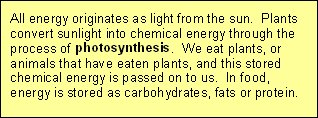 Energy is required for all kinds of bodily processes including growth and development, repair, the transport of various substances between cells and of course, muscle contraction. It is this last area that Exercise Scientists are most interested in when they talk about energy systems.
Energy is required for all kinds of bodily processes including growth and development, repair, the transport of various substances between cells and of course, muscle contraction. It is this last area that Exercise Scientists are most interested in when they talk about energy systems.
Whether it's during a 26-mile marathon run or one explosive movement like a tennis serve, skeletal muscle is powered by one and only one compound... adenosine triphosphate (ATP) (2). However, the body stores only a small quantity of this 'energy currency' within the cells and it’s enough to power just a few seconds of all-out exercise (5). So the body must replace or resynthesize ATP on an ongoing basis. Understanding how it does this is the key to understanding energy systems.
An ATP molecule consists of adenosine and three (tri) inorganic phosphate groups. When a molecule of ATP is combined with water (a process called hydrolysis), the last phosphate group splits away and releases energy. The molecule of adenosine triphosphate now becomes adenosine diphosphate or ADP (2).
 To replenish the limited stores of ATP, chemical reactions add a phosphate group back to ADP to create ATP. This process is called phosphorylation. If this occurs in the presence of oxygen it is labelled aerobic metabolism or oxidative phosphorylation. If it occurs without oxygen it is labelled anaerobic metabolism (2).
To replenish the limited stores of ATP, chemical reactions add a phosphate group back to ADP to create ATP. This process is called phosphorylation. If this occurs in the presence of oxygen it is labelled aerobic metabolism or oxidative phosphorylation. If it occurs without oxygen it is labelled anaerobic metabolism (2).








